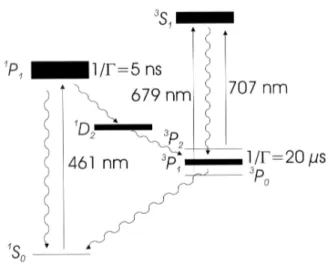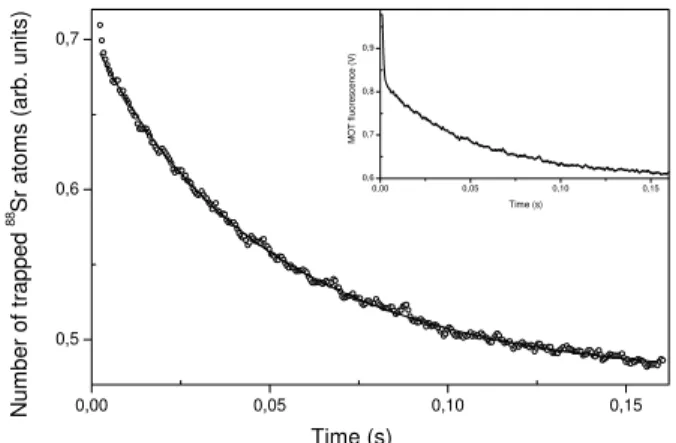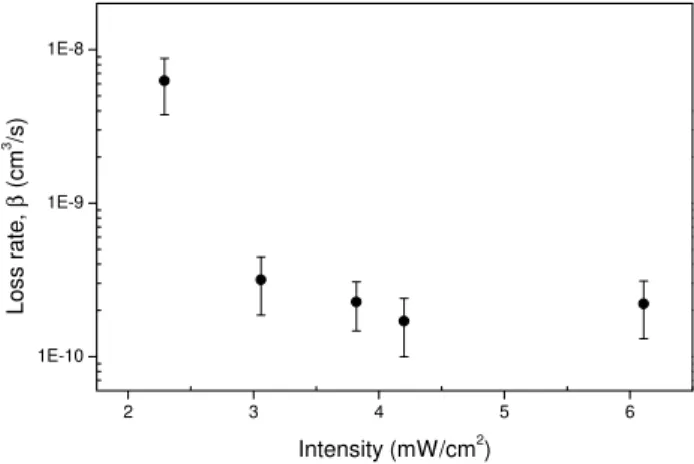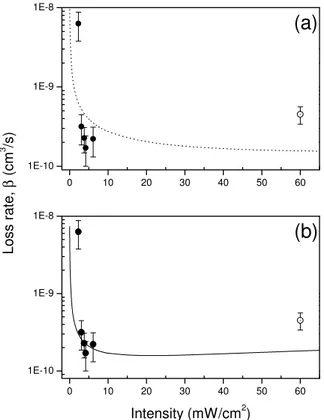Intensity Dependence for Trap Loss Rate in a
Magneto-Optical Trap of Strontium
A. R. L. Caires, G. D. Telles, M. W. Mancini, L. G. Marcassa, V. S. Bagnato,
Instituto de F´ısica de S ˜ao Carlos, Universidade de S ˜ao Paulo, P.O. 369, 13560-970, S ˜ao Carlos, BrazilD. Wilkowski, and R. Kaiser
Laboratorie Ondes & Desordre, FRE 2302 CNRS, 1361 Route Lucioles, F-06560 Valbonne, France
Received on 26 May, 2004
We have measured the collisional loss rate for cold strontium atoms held in a magneto-optical trap as a func-tion of light intensity in the regime of low intensity (2−6 mW/cm
2
). The results confirm our recently proposed model, where we showed that the sudden increase of loss rate at low intensities does not depend on hyperfine structure changing collision only. The model, which is based on radiative escape mechanism and a light inten-sity dependent escape velocity, is able to reproduce quite well the behavior of the experimental observations. The data here reported may be of importance for a recent proposed application for cold trapped88
Sr atoms, as well as other trappable alkaline earth metal atoms such as Ca.
1
Introduction
The ability to produce ultracold atoms has led to the in-vestigation of atomic collisions at very low temperatures [1, 2]. Binary cold collisions play an important role in al-most all the experiments involving cold atoms. Among seve-ral collisional process, the exoergic collisions between trap-ped atoms are a limiting and important process to be studied. Investigation of small-detuning trap loss rate has been exten-sively carried out by several laboratories around the world and the subject has been well reviewed in recent articles [1, 2]. In the alkalis systems, a great degree of difficulties exists for interpretation of the results due to the existence of hyperfine structure. The complex level structure creates a large number of collisional channels, which are hard to describe using an accurate theoretical quantum model. The-refore, it becomes difficult to understand the relative weight of the different loss channels and even the comparison with the experiment. Most of the existing models are oversim-plified and not able to account for all the observed effects. One effect that was clearily associated with the hyperfine structure of alkaline was the rise up of the trap loss rate at low light intensity; which was explained based on hyperfine changing collision (HCC)[3]. On the other hand, the alka-line earth species constitute an excellent system to test cold collisions theories, once they are nuclear spinless and pre-sent no hyperfine structure. The simplified electronic struc-ture of those atoms makes the number of collision channels small enough to allow fair comparison between theory and experiment even in the small detuning regime, and it should not present the rise up of trap loss rate at low intensity.
Alkaline earth cooling and trapping have recently been of considerable interest and, in opposition to alkalis trap
loss, this information is not vastly available. In the case of
88
Sr, the use of an intercombination line cooling allows to obtain temperatures low enough (< 1µK) for considering this system as a promising candidate for producing BEC samples, as well as optical frequency standards.
Several groups around the world have already built mag-neto optical traps (MOT) of Sr [4, 5, 6], and the trap loss due to cold exoergic collisions has been observed and mea-sured a few years ago for a single detuning and a laser beam intensity (∆ =−40 MHz andI= 60 mW/cm2) [4]. Preci-sion frequency measurement of88
Sr lines has recently been reported by two different groups [7, 8]. For all those expe-riments information of trapped atom-atom interactions is an important aspect to evaluate experimental limitations. Cal-culations of collisions between cold alkaline earth atoms in a weak laser field has been carried out [9] providing physical insights towards the importance of different molecular states for trap loss collisions. Nevertheless those information have not yet been experimentally verified. Comparison of trap loss rate experiments with semiclassical theories are impor-tant to reveal the importance of molecular potentials for the exoergic process. Through those experiments one can infer about the long-lived molecular states, in special about the knowledge ofC3constant.
In this paper we report the observation of trap loss col-lisions observed in a magneto optical trap of 88
followed by the results and the model which allowed the in-terpretation of the results.
2
Experimental setup
The cold strontium (88Sr) cloud is produced in a magneto-optical trap (MOT). As an atomic source we used an effusive atomic beam extracted from a 500◦
C oven (Fig. 1). At the output of the oven, the mean velocity of the atoms is too high (∼300 ms−1
) with respect to the capture velocity range of the MOT (∼30 ms−1
). Thus, the atoms have to be decele-rated before reaching the trap zone. For this purpose, a 27 cm long Zeeman slower [10] reduces the longitudinal velo-city within the capture velovelo-city range of the MOT. At 3 cm after the oven and before the Zeeman slower, the hot atoms pass through a small pipe of 1 cm long an 1.5 mm diame-ter. This channel is used to select the transverse velocity of the beam and also as a differential pumping to isolate the hot part with high pressure of the vacuum apparatus from the cold part with low pressure where the MOT is created. Between the oven and collimation channel, a transverse mo-lasses increases the brightness of the beam.
Figure 1. Scheme of the experimental apparatus used in France to decelerate and trap the88Sr atoms.
The Zeeman slower laser, the MOT laser, and the probe laser beams are at 461 nm and they are generated from the same frequency-doubled source. Briefly, a single-mode gra-ting stabilized diode laser is used as an optical oscillator at 922 nm. The full power of the oscillator (15 mW) is injec-ted into a tapered amplifier to produce 500 mW tuned at 922 nm power. The infrared light is then frequency doubled in a semi-monolithic standing wave cavity with an intra-cavity KNbO3; The doubled frequency laser beam exits through a
dichroic mirror providing 150 mW of tunable single-mode light, which is then frequency locked on the 461 nm1
S0− 1
P1strontium line in a heat pipe. An acousto-optic
modula-tor (AOM) is used for subsequent amplitude and frequency variations. The MOT is made of six independent trapping beams, red-detuned by δ = −Γfrom the resonance. The saturation intensityIsfor the1S0−
1
P1line of 88
Sr is 42.5 mW/cm2
and the natural width of the transition isΓ/2π = 32 MHz. Two anti-helmoltz coils create a 100 G/cm magne-tic field gradient to trap the atoms. A small population loss to metastable states is repumped to the ground state using two additional red lasers connecting the 3
P0 and 3P2
me-tastable states to the 3
S1 state (Fig. 2). The atoms then
decay to the 3
P1. The lifetime of 3P1 is short enough
(Γ/2π=7.5 kHz) to recapture the atoms before it leaves the MOT area. The number of trapped atoms of our88
Sr MOT isNat ∼ 107, which is obtained from fluorescence
measurements of the cold cloud in the MOT. From a CCD image, the RMS diameter of the cloud has been estimated to be about 0.6 mm. Thus the peak density of the cloud inn0 ∼ 3x10
9
cm−3
. The RMS velocity of the atoms is ∆v ∼1m/s. The experimental setup used for this work is located in France.
Figure 2. The level diagram for strontium showing the most impor-tant transition wavelengths and decay rates for the MOT operation.
3
Determination and analysis of loss
rate coefficient (
β
)
The cold collision rates for strontium atoms in the MOT are deduced from the trapped sample lifetime measurements. Using high laser intensity (60 mW/cm2
) up to107
atoms are loaded in the MOT at a density of3x109
cm−3
. The sud-den change of intensity technique, developed by Santos [11], was used to measure the trap loss rate at low light intensities. The MOT is loaded at full intensity and then, after the ste-ady state has been reached, the intensity is suddenly reduced by reduzing the RF power into the AOM. After the intensity reduction, the number of trapped atoms decreases to reach a new steady-state value, with a temporal evolution determi-ned by the trap loss rate in the low intensity regime. The transient variation of atom number and density are there-fore monitored by measuring the fluorescence coming from the atoms with a calibrated photodiode and charge-coupled device (CCD) camera. This technique, based on the detec-tion of the unloading of a weak MOT, allows to determine the loss rate also in a very low intensity regime (I < IS),
instantaneous with respect to the rate of change of the num-ber of atoms in the MOT. This criteria is easily achieved using AOMs with typical time response on the order of mi-croseconds. In Fig. 3 we show a typical decay curve of the atomic sample fluorescence that is proportional to the num-ber of trapped atoms observed after the intensity is changed. The population decay of the trap has three major origins. It can be due to losses by background gass, optical pumping and cold exoergic collisions. As a matter of fact, even with the repumping laser beams, the optical pumping losses are not completely avoided. These two loss mechanisms (op-tical pumping and background gass) do not depend on the number of cold atoms present in the trap. The decay rate extracted from these two loss mechanisms is in the order of (50 ms)−1
. The last loss contribution comes from collisions between cold atoms and lead to a density dependence in the decay of the MOT population.
As described above, to obtain the trap loss rate we mea-sure the time evolution of the total number of trapped atoms after the sudden decrease of the laser intensity. The first step is to load the MOT at full intensity during a few seconds. The rate equation describing the loading is:
dN
dt =L0−γN−b0N
2
, (1)
where
b0=
β0
(2π)2/3w3 0
(2)
hereL0andβ0 are the loading rate and the loss rate
resul-ting from collisions among the trapped strontium atoms due to inelastic mechanisms at high intensity respectvally;γis the loss rate due to collisions between the trapped atoms and the hot background vapor andw0is the atomic sample half
waist. So the solution of Eq. 1 is:
0,00 0,05 0,10 0,15
0,5 0,6 0,7
0,00 0,05 0,10 0,15 0,6 0,7 0,8 0,9 Num ber of t rapped
88 Sr at
om s (arb. unit s ) Time (s) Time (s) M O T f luor es c enc e ( V )
Figure 3. Comparison between the fitting generated by the eq.6 and the smoothed unloanding curve. In the inset plot, we show a typical full unloading curve, this curve was obtained by a sudden change of the MOT laser intensity.
⌋
N(t) =
p
4L0b0+γ2
2b0 " tanh à 1 2 p
4L0b0+γ2t−
1 2ln
Ã
−γ−
p
4L0b0+γ2
γ+p4L0b0+γ2
!!
−p γ
4L0b0+γ2
#
(3)
⌈
where the final steady-state number is given by:
N0=
p
4L0b0+γ2−γ
2b0
(4) The second step is to suddenly decrease the trap laser beam intensity down to some fraction of the initial total intensity. Therefore, the rate eq. 1 will have to change to support the new experimental conditions. The new equation has to link two steady-states: the initial, containingN0atoms trapped,
and the final(t→ ∞), containingN1trapped. Also, at the
new intensity, the MOT still continues to load atoms, but with a smaller loading rate,L1, that has to be a fraction of
the initial one (L0), at full intensity. Thus, the time
evo-lution for the trapped strontium atoms, after the intensity decrease, becomes:
dN
dt =L1−γN−b1N
2
(5) where
b1=
β1
(2π)2/3w3 1
The solution for the above rate eq. 5 can be easily found, by ordinary means, simply imposing the correct boundary conditions. That is,
⌋
N(t) = 1
2b
(
dtanh
"
td 2 + ln
p
(d−γ−2bN0) (d+γ+ 2bN0)
d−γ−2bN0
# −γ ) + 1 2b ½ dtanh · 1 2 µ
td−ln
µ
d−t
d+t
¶¶¸
−γ
¾
where:
d=p4L1b1+γ2 (7)
and it presents an exponential decay solution linking the two steady state regimes. Note that in eq.6,N1has to be smaller
thanN0and that is obviously the situation achieved during
the experiment, once the trap laser intensity was suddenly decreased down to a small fraction of the total initial one.
2 3 4 5 6
1E-10 1E-9 1E-8
L
o
ss ra
te
,
β
(cm
3 /s)
Intensity (mW/cm2)
Figure 4. The experimental results from unloanding curve analysis.
The obtained values forβ are displayed in the plot of Fig. 4. We shall observe that at this time we have investi-gated only the low intensity regime, which was technically possible with our system. From the results, the main ob-served fact, besides the absolute values, is that as intensity decreases there is a clear increase of the loss rate. The same behavior occur in alkalis, which was associated with HCC[3]. However here, we can not associate this increase with hyperfine change collisions, rather it can well be ex-plained relying on the mechanism of radiative escape with the correct intensity dependence for the escape velocity. The model to explain such observations was presented in detail in a recent publication[13]. In Brief, our model consider that the loss channels of collisions consists of the collision of one excited, with one ground state atom, and radiative escape as the main loss mechanism. In this process during the colli-sion, one of the atoms is excited by the light field, and the interatomic potential is predominantly of long range charac-terized by1/R3
. Since the collisional times are comparable to the excited-state lifetime, spontaneous emission can take place during the atomic encounter, playing an essential role in the collision dynamics. The occurrence of spontaneous emission in this case causes a suddenly change of the mole-cular state together with the emission of a red-shifted pho-ton, transferring the internal energy of the system to kinetic motion, resulting in a considerable increase of the atomic velocity. If the velocity is not too high, the viscous environ-ment of the MOT is enough to dissipate it, allowing to the atoms to remain trapped. However, if the transferred kinetic energy is too high, atoms can be ejected from the trap. The model was implemented with two approaches. First we have used the conventional way: the decay rate (excited-ground)
does not depend on the internuclear distance. In the second and more realistic approach, we assumed that the spontane-ous decay rate depends on the internuclear distance.
For the first approach, the88
Sr−88
Sr pair absorbs a pho-ton (hνL) and goes to the attractive
88
Sr−88
Sr∗
potential, starting to convert energy from the photon to kinetic motion, as the pair of atoms reaches smaller internuclear distances. The colliding pair may decay during the collision, emitting a photon to the red of the atomic transition (hν0). The energy
difference betweenhνLandhν0is transformed into kinetic
form and shared between the two atoms. If this energy is sufficient high to overcome the trap forces, both atoms will escape from the trap, causing losses. Using this sequence, a model can be implemented to obtainβas defined in equation 1. We start considering the number of atomic pairs locali-zed between the internuclear distanceR andR+dRable to be excited by the trapping laser frequency. Once excited, the pair can survive until short range acquiring velocity that may exceed vesc (escape velocity). Those atoms are
effec-tively the ones that contribute to trap loss. To account for every possible internuclear separation an integration is per-formed overR. The loss rate coefficientβ is thus written as:
β= 1 2
∞
Z
0
4πR2
ǫL(R, νL, I)PRE(R, vesc)dR (8)
whereǫL(R, νL, I)is the excitation rate, which depends on
R, on the laser frequency(νL)and the overall laser intensity
I (which is equal to six times the intensity in each beam). PRE(R, vesc)is the probability that radiative escape will
oc-cur once the pair is excited atR. Observe that the knowledge of vesc(I) is important to perform the integration in eq.8.
The expressions forǫL andPREcan be obtained with a few
steps of calculation [13], resulting in
ǫL(R, νL, I) =
I Is
1 + 4 Γ2 M
¡ ∆− C3
ℏR3
¢2 +IIs
(9)
PRE(R, vesc) =
sinh [ΓMt(R, vesc)]
sinh [ΓMT(R)]
(10) where ΓM is the molecular spontaneous decay rate. ∆ =
νL−νis the detuning between the laser frequency(νL)and
the atomic resonant frequency(ν0),t(R, vesc)is the
classi-cal motion time the atoms spent in a potential region where radiative escape occur, i. e. in this travelling timev > vesc.
The saturation intensity for the considered transition is Is
andT(R)is the time that takes for the atomic pair to go from RtoR = 0(classical half trip time in the potential). Nor-mallytandT are obtained considering the atoms motion in a classical−C3
R3 potential. The term4πR
2
in eq.3, accounts for the number of colliding pairs at the internuclear separa-tion R. To explicitly determine theβ dependence withI, one must know the intensity dependence ofvesc. For this we
0 10 20 30 40 50 60 1E-10
1E-9 1E-8
0 10 20 30 40 50 60 1E-10
1E-9 1E-8
Intensity (mW/cm2)
(b)
L
o
ss ra
te
,
β
(cm
3 /s)
(a)
Figure 5. Plot of the loss rate coefficient as a function of the trap la-ser light intensity. (a) Comparison of the experimental and model results for the case where the linewidth,ΓM, is constant with the
internuclear separation. (b) Comparison with the improved model for the case where the linewidth depends on the internuclear
sepa-ration,ΓM = Γ (R). In these cases, the
1
Πg molecular state was
considered and the theoretical curves were adjusted in the vertical scale by a normalization factor to better fit the data. The dot hollow circle point at 60 mW/cm2
was taken from the ref. [4] to emphasize the agreement with the model results.
The Fig. 5ashows the experimental points together with the described model. For the model we have used as inte-ratomic potential constant C3 = 10 a.u. provided in ref.
[9]. For the purpose of comparison, together with the expe-rimental points obtained in this work we have also provided the obtained result by Dinneenet al.[4]. Besides, obtaining similar behavior between data and model, the absolute va-lues are still far by a factor about 4. An important fact is that the increase ofβ observed for low intensity is predicted in the model. This increase which is normally associated with hyperfine changing collision (HCC), can not be done for pre-sent case, because of the absence of hyperfine structure. The fact that this suddenly increase of losses at low intensity oc-cur even in the system where HCC is not present, confirms our recent published model [13], where the increase ofβ at low intensity is associated with radiative escape mechanism in conjunction with the way thatvesc depends upon to the
light intensity.
To improve the absolute value of our model, we have in-troduced a dependence of ΓMwithR. In this case, we have
used the result obtained by Meath [16]. From Meath, the li-newidth of the1
Πgmolecular state(which is the considered
in our model) as a function of the internuclear separation is given by:
⌋
ΓΠ M= Γa
(
1± 3
2(R¯λ)3
"õ R ¯λ
¶2
−1
! sin
µR ¯λ
¶ +
µR ¯λ
¶ cos
µR ¯λ
¶#)
(11)
⌈
whereΓa and¯λare the atomic decay rate and the reduced
wavelength for the atomic transition, respectively. Using eqs. 11 and 8, we obtain the solid line shown in Fig. 5b. In this case the agreement between data and model is quanti-tatively considered improved, even though the overall beha-vior is the same.
4
Conclusions
We have measured for the first time the trap loss rate depen-dence as a function of light intensity for a88
Sr MOT. The loss rate constant presents a sharp increase for low intensi-ties that can not be due to hyperfine changing collision. This behavior was observed in alkali-metal atoms MOTs and it was associated with HCC. Rather, it can be caused by radia-tive escape in conjunction with the light intensity depending escape velocity. The model based only on radiative escape channel was able to reproduce quite well the behavior of the loss rate coefficient. The model was also improved here by
the introduction of the dependence of linewidth with the separation between the atomic pair. In the near future, we hope these data shall help to improve the88
Sr MOT num-ber and density. It can provide valuable information to set limits for attainable densities and also on the mechanisms involved during the atomic collisions taking place into the MOT, which may be of importance for recent demonstrated precision spectroscopy with such atoms.
Acknowledgments
This work was supported by the Brazilian agencies FA-PESP and CNPq, and the French agencies CNRS and PACA.
References
[1] T. Walker and P. Feng, Adv. At. Mol. Opt. Phys.4, 1085 (1994).
[3] D. Sesko, T. Walker, C. Monroe, A. Gallagher, and C. Wie-man, Phys. Rev. Lett.63, 961 (1989).
[4] T.P. Dinneen, K.R. Vogel, E. Arimondo, J.L. Hall, and A. Gallagher, Phys. Rev. A.59, 1216 (1999)
[5] I. Courtillot, A. Quessada, R.P. Kovacich, J.J. Zondy, A. Lan-dragin, A. Clairon, and P. Lemonde, Opt. Lett.28468 (2003). [6] H. Katori, T. Ido, Y. Isoya, and M. Kuwata-Gonokami, Phys.
Rev. Lett.82, 1116 (1999).
[7] I. Courtillot, A. Quessada, R.P. Kovacich, A. Brush, D. Kol-ker, J.J. Zondy, G. Rovera, and P. Lemonde, ar Xiv: phy-sics/0303023 V1-March-2003
[8] G. Ferrari, P. Cancio, R. Drullinger, G. Giusfrede, N. Poli, M. Prevedelli, C. Toninelli, and G.M. Tino, Prived comm. (June-2003).
[9] M. Machholm, P.S. Julienne, and K.A. Suominen, Phys. Rev. A.64, 033425 (2001).
[10] V.S. Bagnato, C. Salomon, E. Marega, and S.C. Zilio, J. Opt. Soc. Am. B.8, 497(1991).
[11] M.S. Santos, A. Antunes, P. Nussenzveig, J. Flemming, S.C. Zilio, and V.S. Bagnato, Las. Phys.8, 880 (1998).
[12] G.D. Telles, L.G. Marcassa, S.R. Muniz, M.S. Santos, A. An-tunes, and V.S. Bagnato, Las. Phys.10, 21 (2000).
[13] G.D. Telles, V.S. Bagnato, and L.G. Marcassa, Phys. Rev. Lett.86,4469 (2001)
[14] V.S. Bagnato, L.G. Marcassa, S.G. Miranda, S.R Muniz, and A.L. de Oliveira, Phys. Rev. A.62, 013404 (2000)
[15] S.R. Muniz, K.M.F. Magalhaes, P.W. Courteille, M.A. Perez, L.G Marcassa, and V.S. Bagnato, Phys. Rev. A.65, 015402 (2002)



